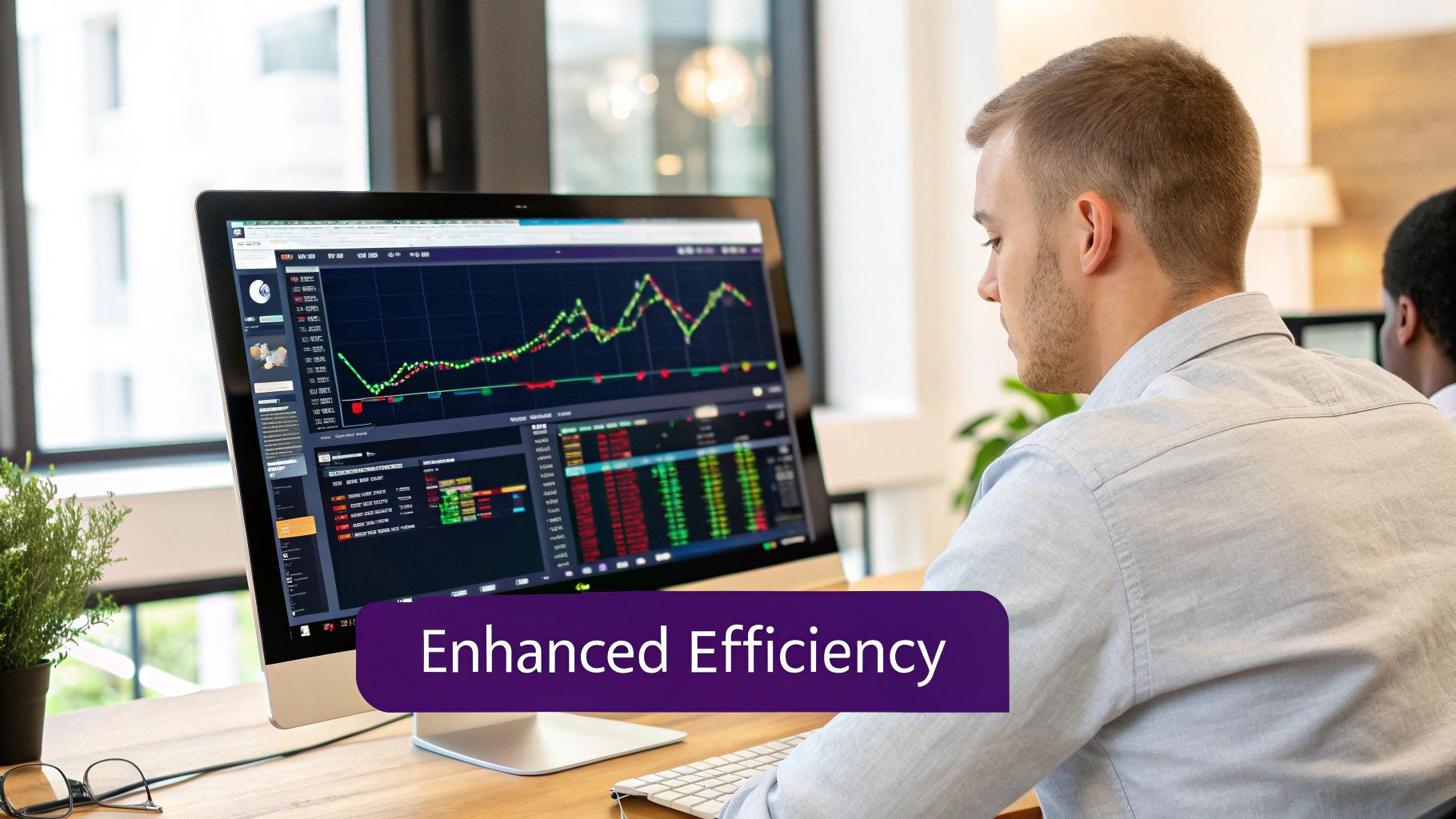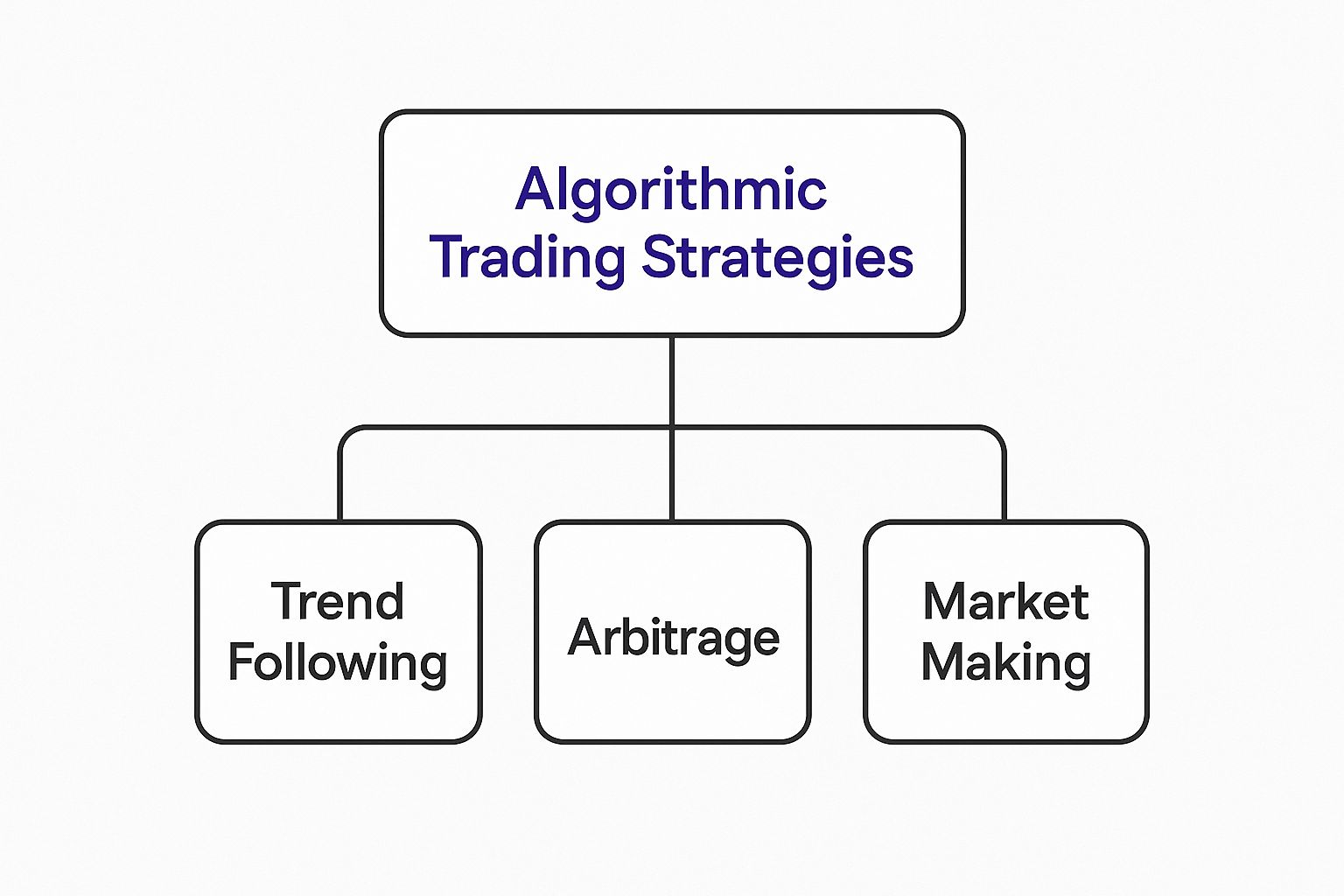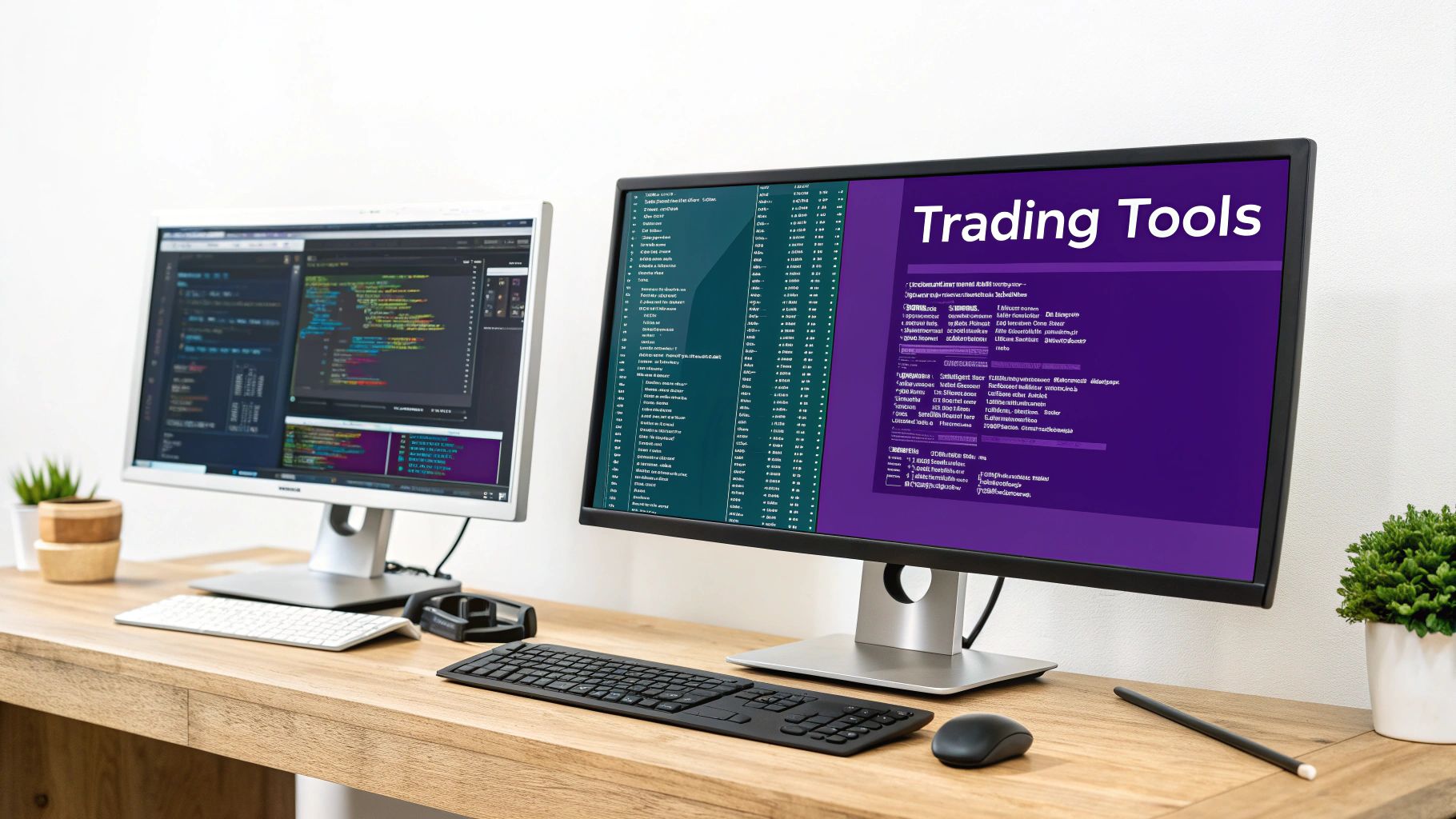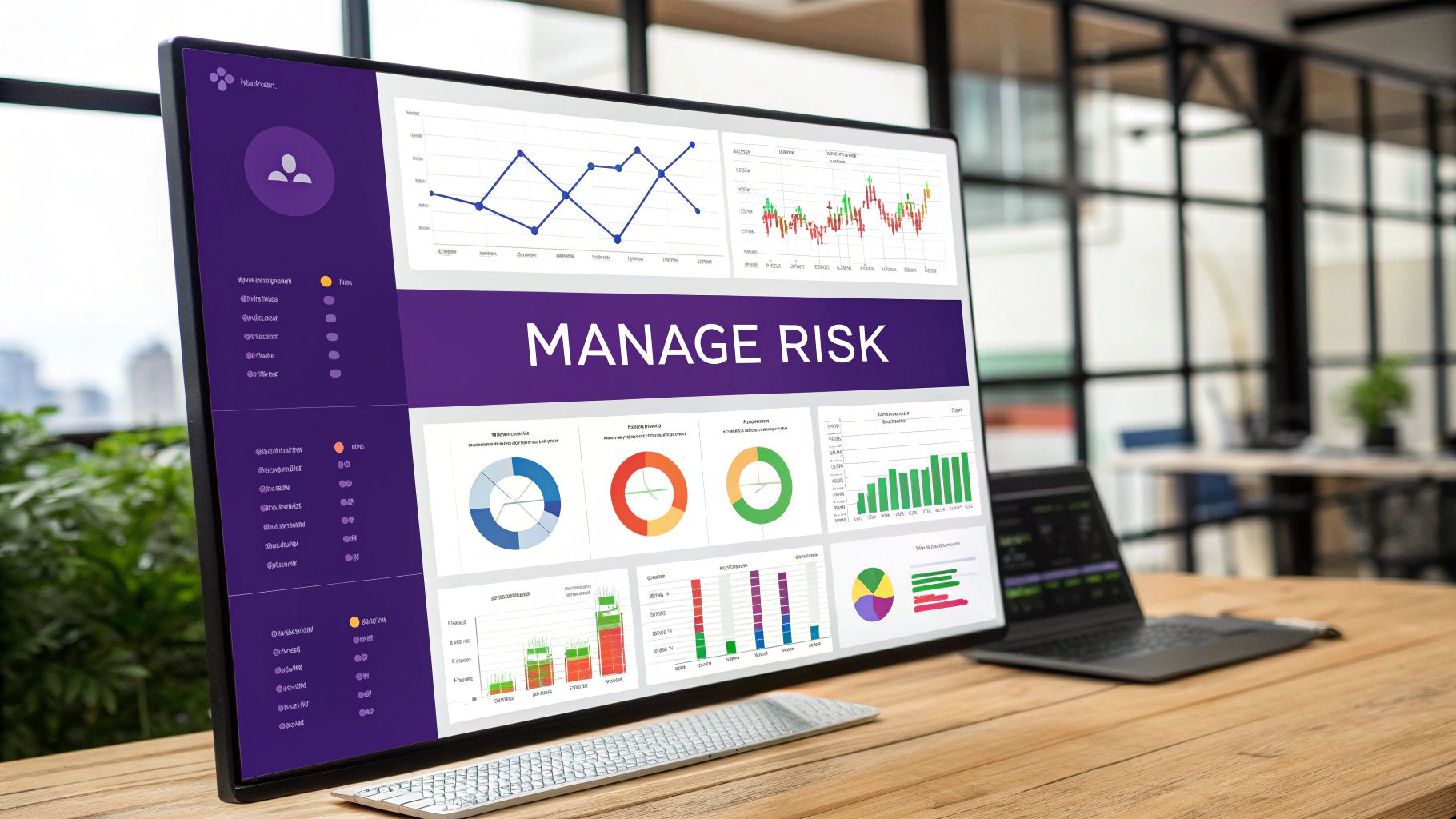Cryptocurrency algorithmic trading is really just about using computer programs to automatically buy and sell crypto for you. These programs follow a very specific set of rules—a pre-defined strategy—to make trades. The biggest advantage? High-speed, emotionless trading that can run 24/7, jumping on market opportunities far quicker than any human ever could.
Decoding Cryptocurrency Algorithmic Trading
Think of an expert chef who can follow an intricate recipe with flawless precision, turning out a perfect dish every single time. That’s the heart of cryptocurrency algorithmic trading. The computer program, or "bot," is the chef, and your trading strategy is its recipe. It constantly looks at market data—price changes, volume, and other signals—and makes trades exactly as you’ve told it to.
This approach immediately gets rid of the two biggest hurdles traders face: emotion and speed. Fear can make you sell at the bottom, and greed can make you buy at the top. On top of that, the crypto market moves so fast that trying to keep up manually is a recipe for frustration. A bot, on the other hand, doesn’t panic during a dip or get euphoric during a rally. It just sticks to the plan.
Why Automation Is Essential
The crypto market simply never stops. Unlike stock markets with their familiar opening and closing bells, digital assets are traded around the clock, all over the world. That relentless pace makes it impossible for one person to catch every good opportunity. Algorithmic trading solves this by acting as your tireless watchman.
By automating your trades, you can tap into global market movements even while you're asleep. Your system is always working for you, making sure you never miss a trade that fits your criteria.
This isn’t some niche tactic anymore; it’s how the market works now. In 2023, automated bots were behind more than 70% of the mind-boggling $94 trillion in global crypto algorithmic trading volume. These systems can place an order in as little as 0.01 seconds—a speed that makes human reaction time look like slow motion. This not only makes trading more efficient but also adds critical liquidity to the market for everyone.
Building Your Foundation
Getting a solid grasp of the core concepts is the first real step. This isn't about handing your assets over to some mysterious "black box" and hoping for the best. It's about you defining a clear, logical strategy that a machine can then execute perfectly on your behalf.
To dive deeper into these foundational topics and build up your knowledge, be sure to check out the resources available at the vTrader Academy.
How an Algorithmic Trading System Works

To really get what’s going on with cryptocurrency algorithmic trading, we need to pop the hood and see what makes these bots tick. It can sound intimidating, but what you’ll find is a surprisingly logical, three-part machine that turns market noise into clean, executed trades. Each piece has one specific job, and when they work together, you get a powerful, automated workflow.
The best analogy? Think of a self-driving car. The car needs to see the road, decide what to do next, and then physically perform the action. A trading bot is running the exact same playbook, just inside the crypto markets.
Let's break down those three core components.
Component 1: The Data Feed
First up, and arguably the most important piece, is the Data Feed. These are the system's eyes and ears, glued to the market 24/7. It's the self-driving car’s network of cameras and sensors, constantly pulling in real-time information about traffic, road conditions, and unexpected obstacles.
In the trading world, the data feed is a firehose of information from crypto exchanges. And we're not just talking about the latest price. It includes a ton of other critical data points:
- Order Book Data: Seeing the live buy and sell orders gives the bot a raw look at supply and demand.
- Trade Volume: A spike in volume can confirm a trend is real, while low volume might signal that a price move doesn't have much conviction behind it.
- On-Chain Metrics: For certain strategies, things like network transaction fees (gas fees) are pure gold. For example, keeping an eye on network congestion with a solid ETH Gas Tracker can tell you a lot about broader market activity.
Bottom line: without a clean, lightning-fast data feed, the whole system is flying blind. The quality of this input directly impacts the quality of every decision the bot makes.
Component 2: The Strategy Logic
Once the data is ingested, it's sent straight to the system's brain: the Strategy Logic. This is the central command where all the decisions are made. It's the self-driving car's onboard computer, taking all that sensor data and deciding whether to speed up, brake, or change lanes based on its programming.
This part of the bot holds all the rules and conditions you've set up—it’s the "secret sauce" of your strategy. A simple rule might look something like this: "If Bitcoin's price crosses its 50-day moving average AND trading volume is 20% higher than normal, then create a 'buy' signal."
The Strategy Logic is where your market theory comes to life. It's the engine that transforms raw data into a clear, actionable signal, telling the system exactly when to pull the trigger.
This is where you get to be creative. The logic can be as simple as a few technical indicators working together or as complex as a machine-learning model hunting for subtle patterns. No matter how it's built, its job is always the same: analyze the data and give a clear "go" or "no-go" signal.
Component 3: The Execution Engine
The final piece of the puzzle is the Execution Engine. These are the hands and feet of the operation. Their only job is to take the signal from the Strategy Logic and turn it into a live trade on an exchange. For our self-driving car, this is the hardware—the engine, steering wheel, and brakes—that physically moves the vehicle.
When the Strategy Logic shouts "BUY!" or "SELL!", the Execution Engine springs into action. It connects to the exchange through an API (Application Programming Interface) and places the order based on the strategy's rules. This includes the order type (like a market or limit order), the amount to trade, and any built-in safety nets, like placing a stop-loss at the same time.
This engine makes sure trades happen instantly and accurately, cutting down on slippage and seizing the opportunity the moment it appears.
Common Algorithmic Trading Strategies
So, you get how a trading bot works. The next big question is: what’s its game plan? This is where the "strategy logic" comes in, acting as the playbook your automated system uses to cut through the noise of the crypto markets. These strategies can be incredibly simple or mind-bendingly complex, each one built to shine under specific market conditions.
Think of it like having a garage full of different types of race cars. You wouldn't take a dragster to a winding rally course. In the same way, the right trading strategy is all about matching your goals, risk appetite, and what the market is doing right now. Let's break down some of the most popular playbooks in the world of crypto algo trading, starting with the basics and working our way up.
This chart lays out the major families that most popular algorithmic approaches fall into.

As you can see, different strategies branch out from core ideas, each giving you a unique way to play the market.
Momentum Trading: Catching the Wave
Momentum trading is probably the easiest strategy to wrap your head around. The logic is dead simple: assets going up will probably keep going up, and assets going down will keep going down. A momentum bot is built to sniff out a strong trend and ride that wave for as long as it has legs.
Picture a surfer. They aren't trying to make waves; they're watching, waiting for a big one to form, and positioning themselves to catch it at just the right second. A momentum algorithm does exactly that, but with price charts. It uses technical indicators like Moving Averages or the Relative Strength Index (RSI) to figure out just how strong a trend really is.
- Entry Signal: The bot might see an asset’s price blast past a major resistance level on high volume. It reads this as the start of a serious uptrend and jumps in with a buy order.
- Exit Signal: It holds on until it detects the trend is losing steam—maybe the price dips below a key moving average or the RSI screams that the asset is overbought.
This strategy absolutely kills it in markets with clear, long-running trends. But it can get chopped to pieces in sideways markets where prices just bounce around with no real direction.
Arbitrage: Exploiting Price Glitches
Arbitrage is the classic "buy low, sell high" mantra, just on steroids and executed at the speed of light across different exchanges. Imagine finding a pair of hyped sneakers selling for $100 on one site but $105 on another. If you could instantly buy them for $100 and flip them for $105, you've just pocketed a risk-free $5.
In the crypto world, arbitrage bots are constantly scanning hundreds of trading pairs across dozens of exchanges, hunting for these tiny price gaps. When one pops up, the bot fires off two trades in the blink of an eye:
- It buys the crypto on the exchange where it’s cheaper.
- It simultaneously sells the exact same amount on the exchange where it's pricier.
The profit on any single trade is usually tiny—often just a fraction of a percent. The magic is in the volume. By cranking out thousands of these trades a day, those tiny profits can stack up into something serious. This isn't about predicting the future; it's about capitalizing on the market's temporary screw-ups.
Arbitrage is a game of pure speed. The price gaps these bots find often exist for mere seconds, which is why automation is non-negotiable. A human trader just can’t click fast enough to compete.
Market Making: Providing Liquidity for a Cut
Market making is a bit more advanced. Here, the bot acts like one of those currency exchange booths you see at the airport. The booth is always offering to buy dollars at one price and sell them at a slightly higher one. That little gap between the buy and sell price—the spread—is how they make their money.
A market-making bot does the exact same thing on a crypto exchange. It places both a buy order (a bid) and a sell order (an ask) for the same crypto at the same time. The goal is to profit from the spread as other traders come along and fill its orders. In doing so, it provides vital liquidity to the market, which actually makes it easier for everyone else to trade. For instance, traders looking for reliable data to inform their strategies can find deep insights in our Bitcoin price prediction guide.
This approach works best for cryptos with tons of trading volume, which ensures the bot’s orders get filled constantly. While it can be a source of steady, consistent returns, it comes with the risk of getting stuck holding a bag of crypto if the price suddenly nosedives.
Comparison of Common Algorithmic Trading Strategies
To help you see how these core strategies stack up against each other, we've put together a quick comparison table. It breaks down what makes each strategy tick, its general risk level, and the kind of market where it's most likely to succeed.
| Strategy | Core Mechanism | Typical Risk Level | Complexity | Ideal Market Condition |
|---|---|---|---|---|
| Momentum Trading | Identifying and following strong price trends using technical indicators. | Medium to High | Low to Medium | Markets with clear, sustained directional trends (bull or bear). |
| Arbitrage | Exploiting small price differences for the same asset across different exchanges. | Low | High | Inefficient markets with price discrepancies and high liquidity. |
| Market Making | Profiting from the bid-ask spread by providing liquidity to the market. | Low to Medium | Medium | High-volume, stable, or sideways-moving markets. |
| Mean Reversion | Betting that asset prices will revert to their historical average over time. | Medium | Medium | "Choppy" or range-bound markets without strong trends. |
Choosing the right strategy isn't just about picking the one that sounds best on paper. It's about finding the one that aligns with your trading style and the specific market conditions you're targeting. Many successful traders even combine elements from different strategies to create a more robust, all-weather system.
The Power of AI in Modern Crypto Trading

If you think of standard, rule-based trading bots as basic calculators—fast and accurate but stuck doing only what you program—then AI-powered systems are the supercomputers of cryptocurrency algorithmic trading. The jump in capability is enormous.
Instead of just blindly following a rigid set of "if-then" commands, bots built with Artificial Intelligence (AI) and Machine Learning (ML) can actually learn, adapt, and evolve their strategies all on their own.
This is the real game-changer. An AI bot doesn’t just execute a strategy; it constantly refines it. It can look back at its own trades, figure out what worked (and what flopped) under certain market conditions, and then tweak its approach for the next time. It’s a continuous feedback loop that makes the bot smarter over time—something a simple rules-based system could never do.
This entire field is exploding thanks to new breakthroughs in AI and the digitization of financial markets. The whole algorithmic trading market, crypto included, was valued at a cool USD 3.28 billion back in 2025 and is set to grow even more, largely fueled by high-frequency trading that can fire off thousands of orders a second. You can dig deeper into the growth drivers in the algorithmic trading market to see just how fast this space is moving.
AI Uncovering Hidden Market Patterns
One of the most mind-bending advantages of AI is its ability to spot connections and patterns that are completely invisible to the human eye. The crypto market spits out a staggering amount of data every single second—far too much for any person to process.
An AI model, however, can churn through all that noise and find subtle, complex links between dozens or even hundreds of different variables.
For instance, an AI might find a weirdly specific relationship between the transaction volume of a small altcoin, how many times it's mentioned on social media in Southeast Asia, and the price of Ethereum. By catching these non-obvious patterns, the AI can build predictive models that give it a serious edge.
AI's real magic is its knack for going beyond surface-level indicators to understand the deep, often chaotic, structure of the market. It doesn't just see what is happening; it finds the why behind the price moves.
Advanced AI Techniques in Action
"AI" isn't just one thing; it's a whole toolbox of powerful techniques. In the trading world, a couple of these have become especially impactful, giving bots entirely new ways to "see" the market and improve on their own.
These methods essentially give trading systems new senses:
- Natural Language Processing (NLP): This lets a bot read and actually understand human language. An NLP-powered algorithm can scan thousands of news articles, tweets, and Reddit threads in real-time to get a feel for market sentiment. It can sense if the online chatter around a coin is turning positive or negative and use that vibe as a trading signal before the market price catches up.
- Reinforcement Learning (RL): Think of this as the AI learning through trial and error, like a person mastering a new video game. The bot gets a "reward" for a profitable trade and a "penalty" for a loss. After running through millions of these simulated trades, it gradually teaches itself the best way to play the game in different market conditions, all without a human telling it what to do.
By pulling in these advanced capabilities, cryptocurrency algorithmic trading is moving beyond being a simple execution tool. It’s becoming an intelligent, adaptive partner that can navigate the wild world of digital assets with a level of skill we've never seen before.
Choosing Your Algorithmic Trading Platform
Picking the right platform for your cryptocurrency algorithmic trading is a lot like a master craftsman choosing their workshop. The right tools don't just get the job done—they make the whole process smoother, safer, and ultimately more profitable. Your platform is the command center where your strategies are born, tested, and launched, so finding one that fits your skill level and trading style is absolutely critical.
The market is flooded with options. You’ve got everything from simple, no-code builders for total beginners to incredibly powerful, developer-focused environments that offer near-limitless customization. Your goal is to find that sweet spot: a platform with all the firepower you need, but without the overwhelming complexity that just gets in the way.

Just look at a modern platform like vTrader. This screenshot shows how complex tools can be made intuitive and accessible. The big takeaway here is that powerful features like strategy building and backtesting don't have to feel intimidating. When done right, they empower traders at every level.
Key Criteria for Platform Selection
Before you even think about signing up, you need a checklist. These are the non-negotiables that will make or break your trading experience and directly impact your security and profitability.
- Supported Exchanges: Can the platform actually trade where you want it to? The more exchanges it connects to, the more opportunities you have for strategies like arbitrage across different markets.
- Backtesting Capabilities: This is your secret weapon, plain and simple. A solid backtesting engine lets you stress-test your ideas against historical market data. It’s how you find out what works—and what doesn't—before you put a single dollar on the line.
- Ease of Use: Does the platform just make sense? A clean, well-designed interface, like what you find on vTrader, turns the often-daunting task of building and deploying bots into a genuinely smooth experience.
- Security Protocols: We’re talking about your money and your data here. Look for must-haves like API key encryption, two-factor authentication (2FA), and a rock-solid privacy policy. Don't compromise on security.
Choosing a platform is all about striking the right balance between power and usability. A system with a million features is useless if you can't figure out how to use them.
Evaluating Costs and Pricing Models
Okay, you’ve found a few platforms with the right features. Now it's time to talk money. Pricing models are all over the map, from monthly subscriptions to fees based on a tiny percentage of your trading volume. You need to know exactly what you’re paying for.
When comparing costs, think about the total value. A platform with a clear, upfront fee structure means no nasty surprises down the road. For instance, knowing the trading fees is essential for calculating your strategy’s true profitability. A transparent breakdown of potential costs helps you see how it all impacts your bottom line. You can see how this works by checking out vTrader's fee structure, which lays everything out clearly.
No-Code Builders vs. Developer Environments
This is where your technical comfort zone comes into play. The final decision often boils down to how you want to build your strategies, which usually sends you down one of two paths.
- No-Code/Low-Code Builders: These are perfect if you're not a programmer. Platforms like vTrader offer visual, drag-and-drop interfaces where you can piece together indicators and logic blocks to create a full-blown strategy without writing a line of code.
- Developer-Focused Platforms: For the coders out there, these platforms provide APIs and SDKs for languages like Python. They offer total freedom to build highly customized, complex algorithms from the ground up.
A great way to get a feel for the landscape is to look at some comprehensive reviews, like these top algorithmic trading software picks. In the end, the best platform is the one that gets out of your way and lets you focus on what really matters: building a winning trading strategy.
Managing Risks in Automated Trading
Let's be clear: letting a bot trade for you offers incredible speed and keeps emotion out of the picture, but it also introduces its own brand of risk. A poorly designed strategy, once automated, can burn through your capital just as fast as it can rack up wins.
This is why building in safety nets isn’t just a good idea—it’s non-negotiable for anyone serious about long-term success. Think of it like putting guardrails on a high-speed racetrack. Without them, one tiny mistake can spiral into a total disaster. These risk management tools are your bot’s brakes and safety features, making sure it stays within limits you’re comfortable with.
The sheer scale of the algorithmic trading market—covering both crypto and traditional assets—underscores how critical these controls are. Valued at roughly USD 21.06 billion in 2024, the market is expected to nearly double to USD 42.99 billion by 2030. This explosive growth is powered by AI and machine learning, which are making bots not just faster, but smarter at managing risk. To get a sense of this evolution, you can dig into the growth trends in the algorithmic trading market.
Essential Risk Management Tools
To protect your hard-earned capital, every single automated strategy needs a few fundamental tools baked in. These are your absolute must-haves.
- Stop-Loss Orders: This is your first and most important line of defense. A stop-loss automatically sells a position once the price drops to a level you’ve set, effectively capping your loss on a single trade. It’s what prevents one bad call from wiping you out.
- Take-Profit Orders: On the flip side, a take-profit order automatically closes a winning trade when it hits your price target. This is how you lock in gains before a sudden market reversal erases them.
- Position Sizing: This is the rule that dictates how much of your capital you’ll put on the line for any given trade. A solid rule of thumb is to risk no more than 1-2% of your total trading capital per trade. This discipline ensures that even a string of losses won’t do catastrophic damage.
Of course, managing risk effectively means you need to be constantly tracking how your strategies are performing. This makes a solid understanding of metrics like Return on Investment (ROI) completely indispensable.
Avoiding the Overfitting Trap
One of the sneakiest and most dangerous pitfalls in building a trading bot is overfitting. This happens when you tweak a strategy so perfectly to past market data that it looks like a world-beater in backtests, only to fall flat on its face in live trading.
Overfitting is like creating a key that flawlessly opens one specific, old lock. The problem is, the market is a collection of thousands of different, ever-changing locks. Your strategy needs to be a master key, not a one-trick pony.
To sidestep this trap, you have to test your strategy across a wide range of market conditions—bull markets, bear markets, and those boring sideways stretches. Don't just test it on the clean dataset where it looked perfect. The goal is to build something robust that can adapt, not a fragile system that only works in hindsight.
Combine these smart tools with a healthy dose of skepticism toward "perfect" backtest results, and you'll be able to trade with far more confidence.
Frequently Asked Questions
Jumping into the world of algorithmic crypto trading is exciting, but it naturally comes with a lot of questions. We get it. Let’s cut through the noise and tackle some of the most common things people ask about profitability, getting started, and keeping your funds safe.
How Much Money Can I Actually Make With Algorithmic Trading?
This is the million-dollar question, isn't it? The honest answer is: it completely depends. There are no guarantees here. Your success boils down to the strength of your strategy, how well you manage risk, and what the market is doing at any given moment.
A well-built, carefully tested bot can absolutely deliver consistent returns. On the flip side, a poorly designed one can lose money just as quickly. A common trap is thinking bots are a "set it and forget it" money machine. The reality is they need ongoing attention, tweaking, and testing to stay sharp. Your profitability comes from the unique edge your strategy has, not just from the act of automating it.
Is This Stuff Really for Beginners?
Yes, it can be, and you don't need a computer science degree to get started anymore. The trick is to walk before you run. Focus on learning the core concepts of trading first, then layer in the automation.
- Start with No-Code Tools: Platforms like vTrader are game-changers. They let you build strategies with drag-and-drop interfaces, so you can focus on your ideas, not on writing code.
- Backtest Everything: This is probably the most critical step for any newcomer. Use historical data to see how your strategy would have performed in the past. It’s like a free practice run before you put real money on the line.
- Understand the "Why": Don't just build a bot; understand why it's making the decisions it makes. That knowledge is what separates successful traders from the rest in the long run.
How Secure Are These Trading Bots?
Security is paramount, and it’s a shared responsibility between you and the platform you choose. Top-tier platforms invest heavily in protecting your account, but your own habits matter just as much.
The most crucial security feature is the API key connection. Your bot connects to an exchange using this key, but you should never, ever grant it withdrawal permissions. This simple setting ensures the bot can place trades for you but can’t physically move funds out of your exchange wallet.
Always pick platforms with solid encryption, turn on two-factor authentication (2FA), and be smart about where you keep your API keys. For a deeper dive into security and other common questions, check out our complete vTrader FAQ page. Taking these simple steps makes automated trading a much safer game to play.
Ready to put theory into practice with a platform built for clarity and power? Join vTrader today to access a zero-fee trading environment, intuitive no-code strategy builders, and a secure ecosystem designed to help you succeed. Start trading with vTrader now.

Steve Gregory is a lawyer in the United States who specializes in licensing for cryptocurrency companies and products. Steve began his career as an attorney in 2015 but made the switch to working in cryptocurrency full time shortly after joining the original team at Gemini Trust Company, an early cryptocurrency exchange based in New York City. Steve then joined CEX.io and was able to launch their regulated US-based cryptocurrency. Steve then went on to become the CEO at currency.com when he ran for four years and was able to lead currency.com to being fully acquired in 2025.


